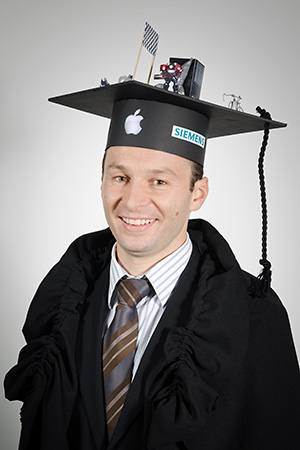Benjamin Keck
High Performance Iterative X-Ray CT with Application in 3-D Mammography and Interventional C-arm Imaging Systems
Abstract
Medical image reconstruction is a key component for a broad range of medical imaging technologies. For classical Computed Tomography systems the amount of measured signals per second increased exponentially over the last four decades, whereas the computational complexity of the majority of utilized algorithms has not changed significantly.
A major interest and challenge is to provide optimal image quality at the fewest patient dose possible. One solution and active research field towards solving that problem, are iterative reconstruction methods. Their complexity is a multiple com- pared to the classical analytical methods which were used in nearly all commercially available systems. In this thesis the application of graphics cards in the field of iterative medical image reconstruction is investigated. The major contributions are the demonstrated fast implementations for off-the-shelf hardware as well as the motivation of graphics card usage in upcoming generations of medical systems. The first realization describes the implementation of a commonly used analytical cone- beam reconstruction method for C-arm CT, before covering iterative reconstruction methods. Both analytical as well as iterative reconstruction methods share the compute-intensive back-projection step. In addition iterative reconstruction methods require a forward-projection step with similarly high computational cost. The introduced Compute Unified Device Architecture (CUDA) builds the basis for the presented GPU implementation of both steps. Different realization schemes are presented by combining both steps and applying minor modifications. The implementations of the SART, SIRT as well as OS-SIRT illustrate the realization of algebraic reconstruction methods. Further, a realization for the more advanced statistical reconstruction methods is described, introducing a GPU accelerated implementation of a maximum likelihood reconstruction using a concave objective function.
The achieved reconstruction performance is based on different detailed optimizations and exploitation of various technical features. In addition the performance results are evaluated for different hardware platforms – like the CPU – and for the proposed algorithms. The results implicate that for all presented reconstruction methods a significant speedup compared to a CPU realization is achieved. In example, we achieve at least a speedup factor of 10 for the presented OS-SIRT com- paring a NVIDIA QuadroFX 5600 graphics card with a workstation equipped with two Intel Xeon Quad-Core E5410 processors. This is additionally supported by the comparison of the presented implementations to the CUDA alternative OpenCL underpinning the performance lead of GPUs using CUDA.
A further contribution of this thesis is the exemplary clinical application of the pro- posed algorithms to two different modalities: C-arm CT and 3-D mammography. These applications demonstrate the potential and importance of GPU accelerated iterative medical image reconstruction. This thesis is concluded with a summary and an outlook on the future of GPU accelerated medical imaging processing.
